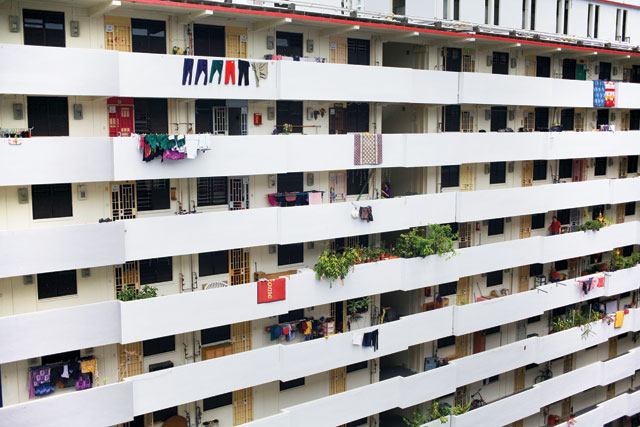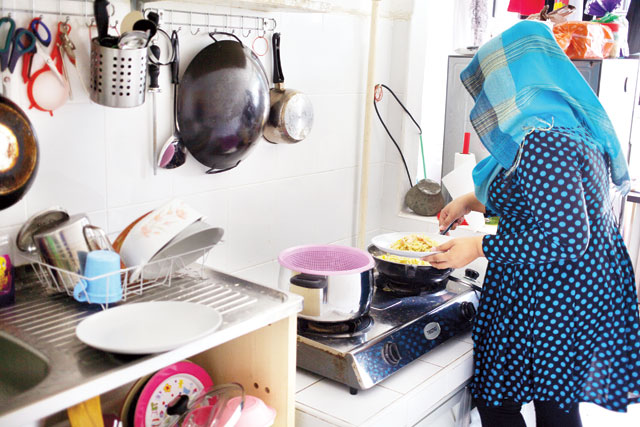The red-and-white apartment blocks are clean, with small shops lining the ground floor. Laundry is strung out on washing lines to dry. Nestled in a typical public housing estate, there is little to indicate that these buildings are state-subsidised rental flats for some of Singapore’s poorest families.
It is an apt visual metaphor; Singapore’s poor aren’t always visible. The government’s refusal to set an official poverty line means that no one knows for sure just how many people are struggling each and every day. But they are there.
Liyana Dhamirah lives in one of these blocks of flats. It was hard-won: Her family had to wait almost two years before they were allocated an apartment. It is small but tidy. Most importantly, it is a stable home for Liyana and her three young children, although the family’s financial struggles are far from over. Liyana’s monthly income of SGD1,200 ($946) has to cover the rent and living expenses of the entire household. She strives to find ways to earn more for her family.
“To live in Singapore and be more comfortable than surviving, you have to be smart in finding ways to earn money,” she says.
Economist Yeoh Lam Keong estimates that 10-12% of Singapore’s households have less than SGD500 ($393) a month for each member. “Taking the average household size of about 3.5 members equals between 385,000 and 490,000 Singapore citizens and residents who find it difficult to meet basic needs such as food, clothing, shelter, transportation, medical and basic out-of-pocket school expenses,” he says.
Most of these households have at least one fully employed member. Thus comes the often-used term of the “working poor” – employment here is no guarantee of financial security. It is a situation that Raju, who lives in the block next to Liyana, understands all too well. His job as a contractor was not enough for him to pay the instalments on his home and he was forced to sell in 2008. He and his family spent the next year moving from rented room to rented room, having to constantly relocate as Raju struggled to pay the rent.
“I was earning SGD1,400 ($1,107) a month, and rental could come up to SGD1,000 ($790),” he recalls, explaining that he often had to rent an extra room to store possessions from his old home. The family of six lived in ten different locations over the course of a year.
The Sunday Times reported in February that 120 families were living in Singapore’s three government-funded homeless shelters. Yet this number does not include those staying with family or friends, sleeping in tents on beaches or in parks, or in the empty ground-floor spaces of housing estates.

In 2009, Liyana and her family lived in a tent in a park for about five months. She was three months pregnant when they started camping, exposed to Singapore’s tropical thunderstorms. “When it was raining heavily we couldn’t stay in the tent because we were afraid that tree branches would fall on it,” Liyana recalls. “We had to go to one of the sheltered areas in the park. I would get drenched, but I just had to be strong. I kept telling myself that I couldn’t afford to be sick, or it would add another burden on us.”
Apart from the weather, the homeless who camp in public parks also have to be wary of park officers. Camping requires a permit, and each person is only allowed a permit of about one week per month. Get caught and a camper would be made to leave and perhaps be issued with a fine.
“If there was a raid we would have to move,” Liyana says. “Once we heard that officers were coming. Someone had a friend who had a lorry so we packed all our belongings and everyone got on board and we went to another park.”
Homeless shelters provide a temporary respite for some and try to provide a low profile, shying away from the press and guarding the identities of inhabitants. Raju remembers the nine months his family spent in a shelter, which was in fact a three-room flat in a housing estate. Multiple families shared the space and each was required to pay about SGD100 ($79) per month for utilities. At one point, 15 people crowded into the small flat.
“When we first got to the shelter, they said we must sleep in the hall,” Raju says, explaining that there were already two families in the bedrooms and that his family only received a room when one of the other groups moved out.
The situation in Singapore may come as a surprise to the outside world. It certainly clashes with the glossy, wealthy exterior the city-state presents. But while its economic success might be the envy of its neighbours, the country also has one of the highest levels of income inequality in the world.
As this income gap continues to widen, the government has realised it is a problem that cannot be ignored and more schemes have been introduced to help low-income earners. Singapore’s 2013 budget saw the Workfare Income Supplement (WIS) scheme, which gives working Singaporeans above a certain age supplementary payouts to boost their income, made available to more people with an increase in the amount of cash payouts. The Workfare Training Support (WTS) scheme also provides heavy subsidies for training courses in an effort to get Singaporean workers to upskill and move into better-paying positions.

In addition to these schemes, the government is adopting the Progressive Wage Model, a system that sets out wage structures according to workers’ skills and productivity. A wage ladder for cleaners will soon be implemented, requiring businesses to pay entry-level cleaners at least SGD1,000 ($787) a month. A similar but voluntary structure has been set out for carpenters in the furniture industry.
However, observers claim much more can be done. Yeoh says the WIS scheme should be further expanded, and there should also be unemployment insurance and pension systems established to deal with the needs of the jobless and elderly.
“They are affordable, relative to our fiscal resources. For example, the marginal cost of trebling WIS payments is only about 0.3% of GDP and can go a long way towards alleviating the suffering and eliminating the problem of the working poor,” he says. “I feel that while we are making more efforts than we used to, and this is commendable, policy as a whole is not doing enough on all these fronts. There is simply no need for poverty to exist at its current level in a prosperous country such as Singapore.”
Meanwhile, Liyana is receiving crucial aid from the state, but admits that dealing with the bureaucracy and red tape can be tough. “Someone less persistent than I am may not get help,” she says, adding that it took her seven or eight attempts at Meet-The-People Sessions before she finally got to see her member of parliament and discuss her family’s homelessness. “It was very difficult,” she says. “You kept getting shoved here and there, from one organisation to another. They don’t share files, so you have to keep telling them your story over and over again. It was physically and emotionally draining.”
Raju agrees, saying he went almost every week to ask for help from his member of parliament. It took a year of these visits before his family was put in a homeless shelter.
“Back then I didn’t see anyone who knew what to do. No one who is homeless in Singapore has written a book and many people have said to me that they didn’t even know there are homeless people here,” she says. “I want to encourage people, to tell them that no matter what, they can move on and not give up.”


